In 2014 it was discovered that a carving of Saint Lucia from the 16th century, located in the chapel of the Dulce Niño de Jesús in Seville, was not that of the saint, but a transvestite carving of Saint John the Evangelist. It seems that the gender change occurred in the thirties of the last century during a restoration of the piece. And if in this case we can talk about a transvestite saint or, rather, the carving of a transvestite saint , history has witnessed saints, nuns and even a transvestite or transformist pope.
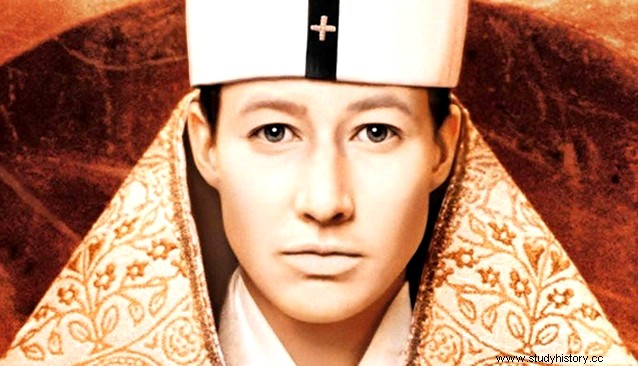
If today, being informed to the second and even directly contemplating the events that occur, there are several versions of the same reality, what to say about what happened centuries ago. It is difficult to separate the wheat from the chaff (the reality of the myth or legend) when the sources are scarce, confused or of doubtful credibility. This is what happened with the legend of Papisa Juana , the only woman who is told that he was Pope. There are several versions of the legend and in different decades, but all place Juana on the throne of Saint Peter in the 9th century. At first she had no problem maintaining the deception, but everything was blown up when she was on a horseback trip and her waters broke... The Pope was giving birth!
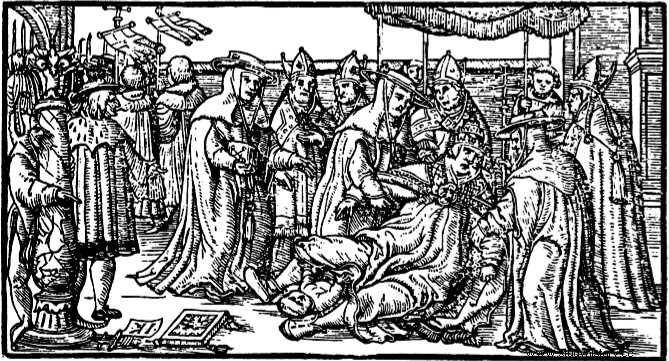
From astonishment he passed to indignation, and from indignation to stoning. Some believe that in this legend —because it is an urban legend— a criticism of the degradation and corruption of the Church of the time, which could have even appointed a woman to occupy the throne of Saint Peter. And from this legend a hoax was born. The Church, so that this situation would not happen again, established a test that all the Popes had to pass:
Duos habet et bene pendentes
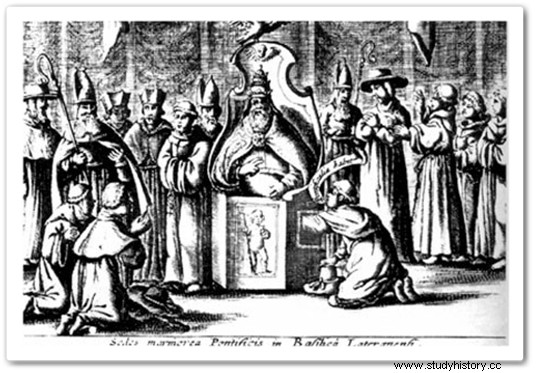
When they were appointed they had to occupy a seat with a hole through which, if they were men, they had to hang their genitals and a cardinal had to visually prove his manhood —other versions say that he was proven by feeling— while shouting:! Duos habet et bene pendentes! (He has two and they hang up on him).
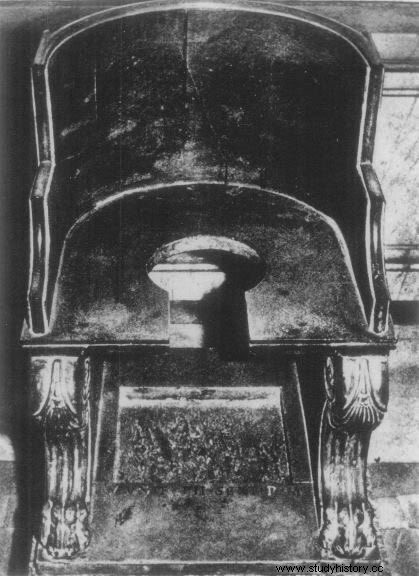
That seat with a hole exists, but it has nothing to do with this story, it's the sedia stercoraria , the excrement chair, where the popes sat to, let's say, read the newspaper. Works of art contributed to the dissemination of this hoax, and of the previous legend, such as that painting in which the test to which Pope Innocent X was subjected is represented, in which a young monk palpates, through a lateral hole , the existence of genitalia, or several that immortalized the birth of Pope Juana (both appear in this article).
For centuries, the only two worthy roles that a woman could play were that of wife, and implicitly mother, or that of nun. Her parents or guardians, family circumstances or simply economic issues determined that women consecrate their lives to their husbands or to God. And both elections involved an economic outlay. Regardless of social status, the woman who wanted to marry had to contribute a dowry that she would receive and administer to her husband. The meaning of this "payment" differs from one author to another, ranging from those who affirm that it is a kind of insurance to avoid repudiation —in this case, the husband should return the dowry—, to those who affirm that it is a compensation that the husband receives for the economic burden of the wife and future children. All the versions of the reason for the dowry imply the condition of inferiority of the woman and even the fact that she is the object of commerce. Likewise, the amount of the dowry was important and conditioned the power to reach an agreement between the parents of the contracting parties, and, logically, to achieve a better marriage —socially speaking—. So that the economic burden would not leave the family coffers trembling at the time of the wedding, the Republic of Florence established in 1425 a public fund called Monte delle doti where parents were making contributions since their daughters were five years old for the future dowry. Special mention in this section deserves Pope Urban VII who, in addition to having the sad record of being the one who has lasted the shortest time in office —from September 15 to 27, 1590—, had the detail of ordering that when all his assets were donated to the charitable association Archicofradía de la Anunciación to provide dowries for girls from poor families. And as he told you, dedicating oneself to religious life also had its cost. Although much less than dowry, most orders also required a financial amount to accept teenage girls. Most of the female convents did not have their own means of subsistence and lived on the donations of third parties (properties left in inheritance by the parishioners, pro anima donations —for the salvation of the souls of the donor or a relative—, payments for being buried in the lands of the convent...) and the contributions made by the new nuns. In this way it was also avoided that many creatures were abandoned at the doors of the convents so that the nuns could raise them. Therefore, and due to this registration canon, it is not surprising that the majority of the nuns were daughters of nobles or wealthy families. And that is what happened to our next protagonist:the Lieutenant Nun .
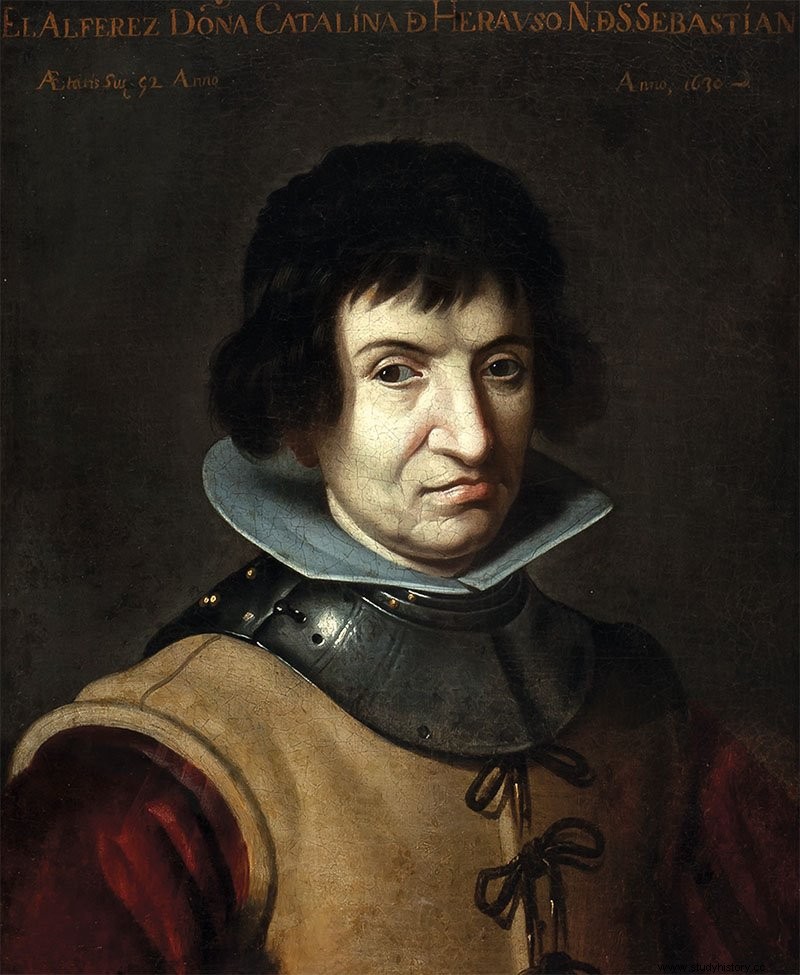
At the end of the 16th century she was born in San Sebastián Catalina de Erauso , daughter of a noble family come to less. The scarcity of resources to be able to provide the corresponding dowry for Catalina closed the door of marriage to her and, as we have said before, she opened the door of the Dominican convent for her. After some problems with other novices and, above all, due to the fact that she did not see herself locked up within those walls the rest of her days, Catalina, already fifteen years old, made the decision to escape from that prison. She didn't know what to do or where to go, and for a while she was wandering around. A woman alone, without direction or destiny, raised many suspicions, so she, she decided to cross-dress and become a man. Without many options, she decided to try the adventure of crossing the pond:she moved to Sanlúcar de Barrameda and embarked for America under the name of Alonso Díaz y Ramírez de Guzmán . Already in America, and enlisted as a soldier, she gained a reputation for bravery and bravery, which helped her to be appointed ensign-bearer of the armies of Spain and the Indies. When the battle was over, he acted like the rest of the soldiers:drunkenness, fights, gambling... but always hiding his true identity. Something that doesn't seem to cost him much because even on occasion...
she walked between the legs of some maiden.
And even she had to run away from some marriage commitment. Until the inevitable happened. Faced with an imminent execution due to problems with the law, he asked for help from the Bishop of Cuzco, before whom he confessed. She related all her adventures from her days in the convent until that precise moment and only when the matrons certified that she was a woman and, moreover, a virgin, did the bishop believe her. He did not know what to do with her, so he decided to send her back to Spain and let the king, Felipe IV, make a decision for her. In 1624 she appeared before Felipe IV as Catalina de Erauso, ensign-bearer of the Armies of Spain and the Indies. The King studied the detailed report issued from Cuzco and, forgetting the little problems with the law, sentenced:
I wish Spain had many soldiers like her.
The Lieutenant Nun, as she was called, asked the King to return to her service, but dressed "officially" as a man. The King told her that it should be the Pope who gave him her permission to wear male clothes. Catalina traveled to Rome to request papal authorization and Urban VIII, thanks to the recommendation of the King of Spain, granted it. Already with his condition as a man, in relation to clothing, he traveled to Naples, where he became the talk of the pimps...
Where is Lady Catherine going? To give you some blows, ladies whores, and a few stab wounds to whoever dares to defend them —she answered Catalina —.
Later, she returned to America and there she passed away. Her remains rest in the church of San Juan de Dios in the city of Orizaba (Mexico).
And yes, the legend speaks of the Holy transvestites , a group of women who, for one reason or another, disguised themselves as men and consecrated their lives to God… as men. Saint Eugenia and Saint Euphrosyne (fleeing from an arranged marriage), Saint Pelagia of Antioch (she left everything and lived her last thirteen years praying and meditating in a hidden cave under the name of Pelagius), Saint Apolinaria, Saint Anastasia… and Santa Marina . And it is about this last saint that I am going to tell you her story because of the strange and amazing circumstances that surrounded her life or her legend in the 5th century.
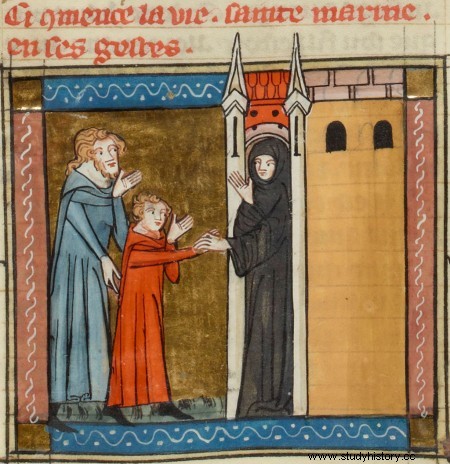
Eugenio and Marina
Marina was the only daughter of Eugene, a devout Christian from Bithynia (Asia Minor, now Turkey) who became a widower shortly after Marina was born. Shattered by the loss of his wife, he dedicated his life to raising her daughter as her father and mother, educating her in the Christian faith, and gathering her dowry to provide her with a good marriage. Then he would take the robes and retire to the Qannoubine monastery (now Lebanon). When the time came to look for a husband, Eugenio shared her plans with Marina, but she found herself unable to separate from her father. Her father's decision was firm and she couldn't take her with him. As a woman, no, but as a man, yes,” Marina said. Unable to change her mind, Eugenio helped her daughter change her appearance and they both went to the monastery. The money raised for the dowry was used to pay for her admission. Eugenio and Marino, formerly Marina, entered the monastic community, sharing a cell until their father's death ten years later. Alone, she continued to hide her condition. Shortly after, and on one of Marino's outings with other monks, the night surprised them far from the monastery and they had to spend the night in an inn on the road. That night, and not far from where the monks were sleeping, the innkeeper's daughter was raped by a soldier who was also staying there. That fact, in which Marino had nothing to do, would change his life. The next morning, they returned to the monastery and Marino continued with his pious life. A few months later the innkeeper came before the abbot accusing Marino of having raped his daughter. It would have been as simple as revealing that she was a woman and that it was a gross lie, but she would have been expelled from it and she could not conceive of a life outside the walls of the monastery. Marina took that accusation as a penance for the trick of pretending to be a man and she did not try to defend herself against it. Although surprised, the abbot had no choice but to expel him. With nowhere to go, Marino stayed in the ruins of a house near the place that had been his home since he entered with his father. When the innkeeper's daughter gave birth, the grandfather took the baby to her supposed father to take care of him. And again without question, he accepted it.
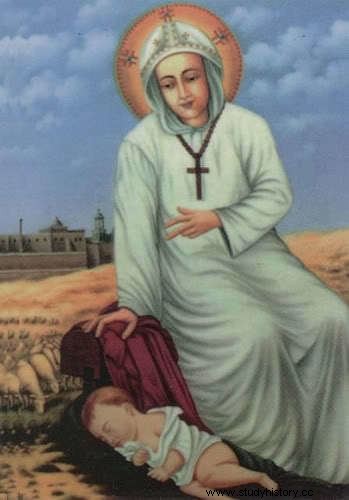
Thus they spent several years, father and putative son praying and living on what the monks could bring them and on the charity of some locals. With the intercession of the monks, and after several years of hardship, the abbot allowed Marino and his son to return.
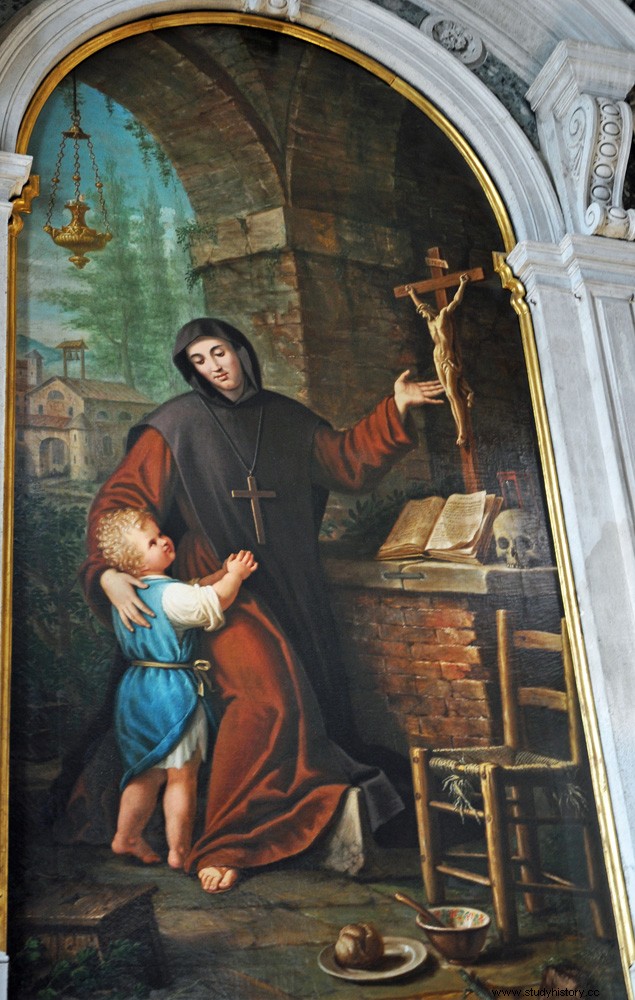
Lattanzio Querena, The Holy Virgin Marina, c. 1830
Shortly thereafter, Marino fell ill and passed away. At that time, when his body was being prepared for Christian burial, it was discovered that she was a woman. A punch of reality hit everyone:Marino had been the silent victim of that story. The abbot ordered the innkeeper to be summoned so that he himself could see irrefutable proof that he accused an innocent man. When the innkeeper questioned her daughter, she confessed that she had been raped by a soldier and that he threatened to kill her if she told the truth about her. She had to look for a guilty party to accuse... and it was Marino's turn. They all wept bitterly for feeling responsible, to a greater or lesser extent, for that terrible injustice. Marina was buried in the monastery and the boy followed the monastic life of his putative father.
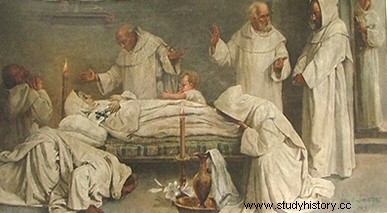
Saint Marina is venerated in many places in Europe (Spain, Italy, France...) and also by the Maronite Catholic Church (Lebanon, Syria, Egypt...), being the patron saint of many peoples, especially Italians.
